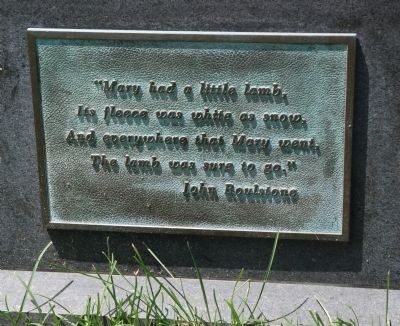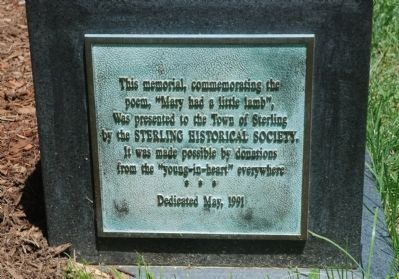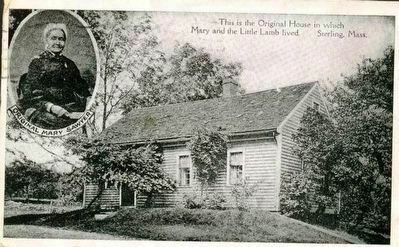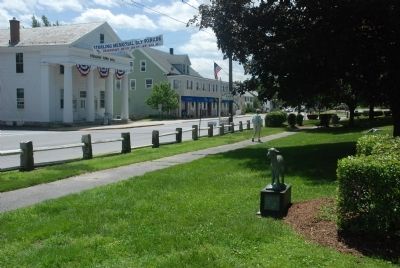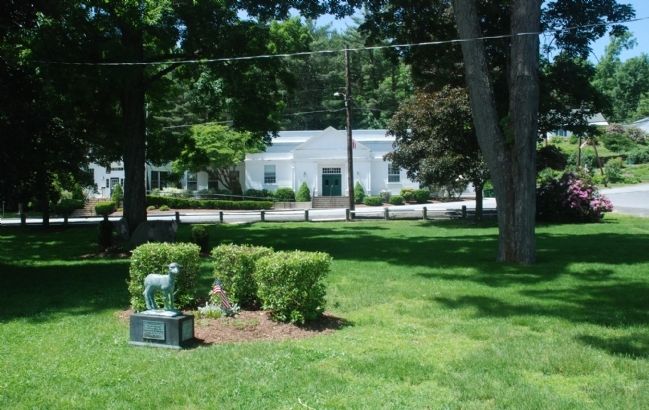Sterling in Worcester County, Massachusetts — The American Northeast (New England)
"Mary Had a Little Lamb"
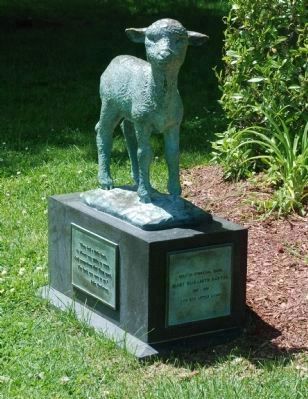
Photographed By Roger W. Sinnott, May 30, 2010
1. “Mary Had a Little Lamb” Monument
Bronze by Rosalind Waters is approximately 2 feet tall on a 1½ foot tall Johannesburg granite base.
Ms. Waters reports that the model was a 6 week old Merino ewe (the common wool sheep in New England in the beginning of the 19th century) raised by a teenage girl from Hubbardson, Massachusetts, as a 4-H project. The artist's signature is on the bronze base. —Ed.
Ms. Waters reports that the model was a 6 week old Merino ewe (the common wool sheep in New England in the beginning of the 19th century) raised by a teenage girl from Hubbardson, Massachusetts, as a 4-H project. The artist's signature is on the bronze base. —Ed.
Erected 1991 by Sterling Historical Society.
Topics. This historical marker is listed in these topic lists: Animals • Arts, Letters, Music • Women. A significant historical year for this entry is 1991.
Location. 42° 26.278′ N, 71° 45.601′ W. Marker is in Sterling, Massachusetts, in Worcester County. Marker is on Main Street (Massachusetts Route 62), on the left when traveling east. Marker is on the town common. Touch for map. Marker is in this post office area: Sterling MA 01564, United States of America. Touch for directions.
Other nearby markers. At least 8 other markers are within 5 miles of this marker, measured as the crow flies. Lafayette’s Tour (within shouting distance of this marker); Mary Sawyer’s Birthplace (approx. 1.3 miles away); Lancaster (approx. 2.1 miles away); Rowlandson Rock (approx. 3.1 miles away); a different marker also named Rowlandson Rock (approx. 3.7 miles away); Prescott Grist Mill (approx. 4 miles away); Sawyer-Carter Bridge (approx. 4 miles away); Wickapickit Brook and Bridge (approx. 4.2 miles away). Touch for a list and map of all markers in Sterling.
Regarding "Mary Had a Little Lamb". One of the most famous of all nursery rhymes seems to have originated with a schoolgirl named Mary Elizabeth Sawyer and her lamb, who lived in Sterling, Massachusetts. As this marker indicates, the first few lines are attributed to Mary’s schoolmate, John Roulstone. They likely inspired Sarah Josepha Hale of Boston to write her much longer poem in 1830. A few years later the poem was set to song, and its lyrics are quoted on Wikipedia (see the link below). William S. and Ceil Baring-Gould, in The Annotated Mother Goose, note that the poem’s popularity soared after it appeared in the 1857 edition of McGuffey’s Second Reader.
Thomas A. Edison, to test his prototype phonograph in 1877, shouted the first few lines of “Mary Had a Little Lamb” into a diaphragm connected to a rotating cylinder wrapped with tinfoil. When played back, the recording astonished all who heard it — Edison included.
Another American inventor, Henry Ford, bought the small Redstone School in Sterling that Mary Sawyer had attended with her lamb. (The poem’s second stanza begins, “It followed her to school one day.”) Ford moved this schoolhouse to nearby Sudbury, Massachusetts, and placed it on the grounds of the Wayside Inn, which he also owned early in the 20th century.
Also see . . .
1. Wikipedia article. Discusses the likelihood that Mary Elizabeth Sawyer’s friend John Roulstone wrote the first four lines of “Mary Had a Little Lamb” and poet Sarah Josepha Hale fleshed it out with additional stanzas. (Submitted on May 31, 2010, by Roger W. Sinnott of Chelmsford, Massachusetts.)
2. Edison’s voice. The 1877 recording of “Mary Had a Little Lamb” was lost, but late in life Thomas A. Edison gave this repeat performance. (Submitted on May 31, 2010, by Roger W. Sinnott of Chelmsford, Massachusetts.)
Credits. This page was last revised on April 20, 2018. It was originally submitted on May 31, 2010, by Roger W. Sinnott of Chelmsford, Massachusetts. This page has been viewed 4,743 times since then and 124 times this year. Last updated on October 17, 2011, by Michael Tiernan of Danvers, Massachusetts. Photos: 1, 2, 3. submitted on May 31, 2010, by Roger W. Sinnott of Chelmsford, Massachusetts. 4. submitted on October 1, 2015. 5, 6. submitted on May 31, 2010, by Roger W. Sinnott of Chelmsford, Massachusetts. • Bill Pfingsten was the editor who published this page.
